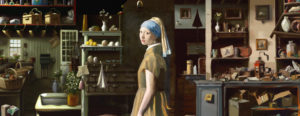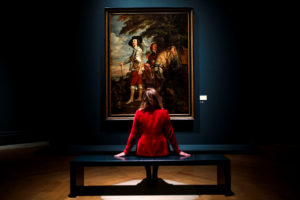Think of poor Antonio Mini. Once a student of Michelangelo, Mini is now remembered as the most famous slacker in the history of European art. One day, the maestro sketched a couple of Virgins and instructed his pupil to copy them. The results were mixed. Mini’s efforts are lovely in their way, but they have a rushed and careless air. Five hundred years later, his homework sits in the British Museum, still inked with Michelangelo’s staccato critique: “Draw Antonio draw Antonio / draw and do not waste time.”
I had already wasted a few decades by the time I started drawing. No matter. I wanted a pastime that didn’t involve a screen. I was left with a choice between drawing and fishing. I chose the former because you need a car to reach most fishing spots, and I don’t have one. This was how I found myself boarding the bus to Dublin for a weekly evening class at the Drawing School. Classes take place in a roomy basement studio beneath Merrion Square, where serene plaster casts watch over rows of students as they work. The primary activity for a novice like me is deceptively simple. You are asked to copy a model drawing. The copy should be as exact as you can make it. The angle of every line, the internal proportions of the form, and the interplay of light and shadow must be faithfully reproduced.
This is incredibly difficult to do. The human eye is an awful cheat. You can be quite pleased with your copy until you put it next to the original and see what a mess you’ve made of everything. An ear too high, a shadow not half as dark as it needs to be. It’s a frustrating process, but compelling too. Students of all ages are genuinely absorbed in their work. The quiet is broken only by the occasional rasp of a pencil sharpener or the hushed advice of the instructors as they rove among the easels.
The model drawings are taken from the Cours de Dessin of Charles Bargue and Jean-Léon Gérôme, a three-volume manual published between 1868 and 1873. The Cours offers a series of drawings of progressive difficulty. Plate 1 is devoted to the human eye, Plate 28 depicts a crouched female leg, Plate 52 is a bust of Brutus, and so on. Bargue drew all of the images himself, selecting examples from ancient statuary that would provide students with the best lessons in form, line and tonal value. This means that a student copies Bargue’s drawing of a cast made from a statue inspired (in most cases) by a human model. Such a daisy chain of reproduction might seem absurd. In fact, it places the student in a tradition of artistic training that stretches back to Antonio Mini and beyond.
Picasso is known to have used the Cours as a teenager, but the method’s most enthusiastic proponent was Vincent Van Gogh: “It invigorates my pencil,” he said. In September 1880, he wrote: “I work regularly on the Cours de Dessin Bargue, and intend to finish it before I undertake anything else, for each day it makes my hand as well as my mind more supple and strong.” Although copying was an arduous and frustrating process, Van Gogh described it as “nothing other than a labour of giving birth. First pain, then joy afterwards.” Ten years later, just weeks before his death, he was planning to work through the Cours again.
The point of all that copying is to charm the cheating eye into submission and learn to really see. But most art schools today do not seem particularly interested in teaching their students this foundational skill. Drawing remains a central component of the BA Fine Art at City & Guilds, Falmouth University offers a dedicated BA Drawing degree, and The Royal Drawing School has become famous for its postgraduate Drawing Year. But the majority of art schools now focus on other activities, and those who want to learn traditional skills must look elsewhere.
“Why have people stopped drawing?” as a perplexed David Hockney recently asked. Around 1920, art education in Britain began with observational drawing; first of prints and casts, then of the living human figure. You had to earn your way to the life model through practice and dedication. And there was an academic component, too: anatomy, geometry, art history. Only then could the serious work of painting and sculpting begin. Although a very different experience to Michelangelo’s workshop, it was a training that Antonio Mini would have recognised.
By the Eighties, however, this traditional education had largely disappeared from Britain’s art schools. Samuel Horler, who founded the Dublin Drawing School I attended in 2010, says his father witnessed the shift first-hand: “As a student he did life-modelling to get a bit of money. He would go out to all the art schools in London and he said it was the easiest work because no one would show up to class. So he would just sit there and wouldn’t have to do much posing because no one was coming, they were all into new media suddenly.”
William Coldstream, whose eponymous committee recommended a series of sweeping reforms to art education between 1960 and 1970, usually gets the blame for the elevation of ideas over practice. But as painter and writer Jacob Willer has shown, the death of the old order was a complex and lengthy process that began long before the Coldstream Committee was first assembled. Heads were already being turned by French abstractionism in the Twenties, a movement that did not require its adherents to be able to draw a convincing human hand. Photography’s ever-increasing reach had an equally dampening effect on realism. And by the Thirties, a peculiarly British interpretation of the Bauhaus Movement was taking hold. Walter Gropius’s 1919 Manifesto is a short exhortation to return to the crafts, or Handwerk: “[Artists] must return to the workshop. This world of mere drawing and painting of draughtsmen and applied artists must at long last become a world that builds.” In its British incarnation, Bauhaus became a rallying cry for those who wished to banish “mere drawing” from the art schools — the only problem was that most forgot to return to the workshop after they had done so.
Jacob Willer has argued that the true break from the past came when art education opened its doors to fashion’s unceasing churn and found that it could not close them again. Bauhaus Modernism was swept away by Pop Art, and the modish tide has continued to go in and out ever since. We’re all supposed to be artists now, isn’t that right? I am not so sure. Nouns tend to lose their meaning when universally applied. That is certainly Horler’s view on the matter. His grandmother is the celebrated sculptor Imogen Stuart, a member of both the Royal Hibernian Academy and Aosdána. In 2015, Stuart was elected Saoi, Ireland’s highest cultural honour. Despite these accolades, Stuart knows that there is always more to learn: “She’s hesitant about calling herself an artist,” says Horler, “And that is quite a traditional view. It shows how misunderstood art is today, that people can just call themselves artists… From the Renaissance right up until at least the Twenties, you had to qualify. And that’s missing now.”
Horler’s Drawing School is one of an increasing number of institutions trying to bridge the artistic skills gap. These range from the glossy Florence Academy of Art and New York City’s Grand Central Atelier to boutique outfits such as the Glasgow Academy of Fine Art. Teaching approaches vary, but all these academies and ateliers are united by a conviction that learning to draw accurately and beautifully is an essential starting point for any artist. Naturally, not everyone has the time and money to attend these schools. But teaching yourself to draw has probably never been easier. Books on the subject are legion and thriving drawing communities exist online. YouTube channels such as ProkoTV pull in millions of subscribers, while digitised museum collections make it possible to learn from the work of supremely gifted and classically trained artists like Käthe Kollwitz and Thomas Anschutz. (Still, I suspect there’s no real substitute for a teacher looming up behind you and murmuring “what’s going on with that nose, Alex?”)
The growth of atelier education has not been universally welcomed. Despite being a critic of the contemporary art world, Willer has little time for the revival of 19th-century teaching methods either. Of both approaches he writes “they do not know what they do not know”. So, while many art schools are now little more than community theatre for the upper-middle classes, ateliers that offer a supposed recreation of a Parisian studio circa 1880 risk becoming a stultifying dead-end. Clearly, a curriculum that marries hard-won skill with creative expression is the ideal to strive for. Some argue that the only solution is to resume the Renaissance practice of seeking out a master willing to impart his or her wisdom in a private setting, away from the institutions and their various diktats.
Art schools and ateliers have their respective ultras, but Horler is not among them. For him, observational drawing is a useful tool for beginners and a handy refresher for the experienced, not an article of faith. Copying provides a solid technical grounding and a set of objective criteria through which a student’s work can be evaluated. A student working through the Cours de Dessin is not making art, he says: “I always tell students that I’m not an art school, I’m not teaching art. But you learn certain skills and techniques that will help you as an artist.”
I still draw most days. Nothing special. Household clutter, mostly. I attempted the dozing figure in Francisco Goya’s “The Sleep of Reason Produces Monsters” a few weeks ago and was pleased with the result, until I noticed that my copy’s legs were much too small. In my case, the sleep of reason produces shrunken tibia. So I drew it again. And again. There is a compulsive element to drawing that I had not anticipated. I think it is a result of trying to see, really see. After three hours, I would walk out into Merrion Square to find that it had been rolled up and replaced with ink-damp forms and strange prospects. A busy garden square in central Dublin was now a question, the same question that Antonio Mini must have asked himself 500 years ago — how would I draw that?
Disclaimer
Some of the posts we share are controversial and we do not necessarily agree with them in the whole extend. Sometimes we agree with the content or part of it but we do not agree with the narration or language. Nevertheless we find them somehow interesting, valuable and/or informative or we share them, because we strongly believe in freedom of speech, free press and journalism. We strongly encourage you to have a critical approach to all the content, do your own research and analysis to build your own opinion.
We would be glad to have your feedback.
Source: UnHerd Read the original article here: https://unherd.com/




